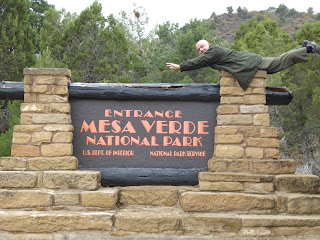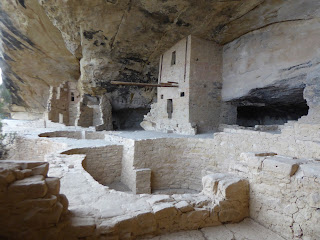Mesa Verde is a different sort of National Park, focused on human history rather than geological/geographical wonders.
Mesas (Spanish for 'table') are the sheer sided hills with fairly flat tops. They can be huge, many miles long or/and wide. Mesa Verde is one that was inhabited by Ancestral Pueblo people (native Americans who are the ancestors of a number of tribes) from 600-1300 BC, 700 years!
Living on top of the mesa gave a number of benefits. There tends to be more rain in what is a very dry region, which makes it easier to grow crops. This particular mesa slopes slightly towards the south, giving it warmer temperatures and a longer growing season.
When I grew up, I thought all American Indians lived in wigwams and teepees. Turns out this is not the case at all, that was only for the tribes that lived a nomadic life on the plains. The Pueblo built a variety of homes, initially made of wood and mud, and eventually moving on to stone structures. Mesa Verde is home to many examples of these stone buildings, which not only are significant and solid structures, but also built in shallow caves on the cliff face. Below is Cliff Palace, the largest of the dwellings.
We went to visit Balcony House, named so because it has a balcony! The dwelling has 40 rooms, including 2 kivas. The route to get there has been made easier to give tourists access, with paths, stairs and wooden ladders, but it was still pretty darn difficult to do. Originally, only hand holds in the cliff face were used (and possibly ladders).
 |
| Linda, bravely facing down her claustrophobia and heading into the first of several narrow and dark tunnels |
 |
| Michael, our ranger for the trip who seemed a bit new at this lark |
 |
| The Balcony |
 |
| One of the kivas |
They aren't 100% sure what kivas were for. They are 3/4 buried underground, and the kivas on Mesa Verde also have notable architectural differences to other kivas elsewhere. They may have had religious significance, been a place for rituals, a place for communal work or socializing. Having an oral rather than written history has made it very difficult to understand what a lot of things were for here.
Balcony House was built over 70 years, and very late on in the construction, a defensive tunnel entrance was added, but noone knows why it was suddenly needed.
 |
| Pinon Jay |
 |
| Unknown tree |
 |
| Juniper Titmouse |
 |
| Trunks left from a wildfire on the mesa 20 years ago |
 |
| The Mesa just after dawn |
























I was not sure about your previous "Pinyon Jay", but today's is definitely a Western Scrub Jay (white eyebrow is the clincher). Love the Titmouse and the the India town pictures. Love Dad
ReplyDeleteThe belly isn't white though, definitely blue. I am using the Merlin app from Cornell Labs for my identifying.
Delete